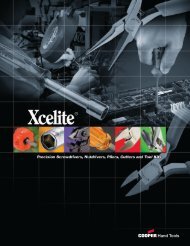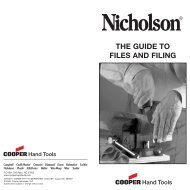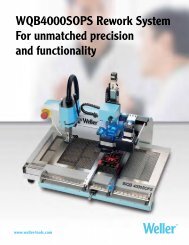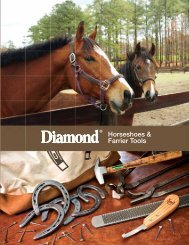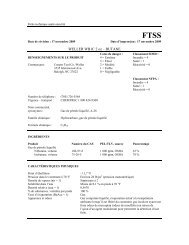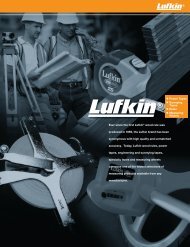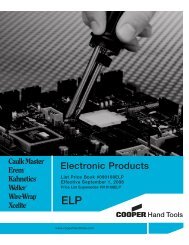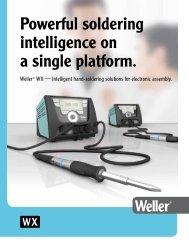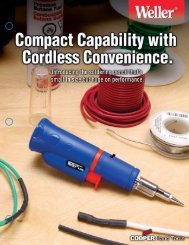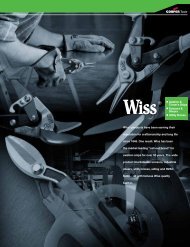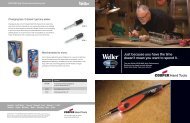Weller Wick MSDS English - Cooper Hand Tools
Weller Wick MSDS English - Cooper Hand Tools
Weller Wick MSDS English - Cooper Hand Tools
Create successful ePaper yourself
Turn your PDF publications into a flip-book with our unique Google optimized e-Paper software.
Material Safety Data Sheet WELLER-WICK<br />
Page 1 of 5<br />
1. IDENTIFICATION OF THE SUBSTANCE/PREPARATION AND OF THE COMPANY/UNDERTAKING.<br />
1.1 Identification of substance (as per label):<br />
Other means of identification:<br />
<strong>Weller</strong>-<strong>Wick</strong> Desoldering Braid.<br />
Part Number: 5011, 5012, 5013, 5014<br />
1.2 MANUFACTURER’S NAME:<br />
Easy Braid Company<br />
6751 Oxford Street<br />
Minneapolis, MN 55426<br />
EMERGENCY TELEPHONE NUMBER:<br />
ORIGINATION DATE: July, 1996<br />
REVISION DATE: April 30, 1999<br />
DISTRIBUTOR NAME:<br />
<strong>Cooper</strong> <strong>Tools</strong><br />
3535 Glenwood Avenue<br />
Raleigh, NC 27612<br />
Information: 919-783-2126<br />
2. COMPOSITION/IDENTIFICATION ON INGREDIENTS<br />
CAS<br />
NUMBER INGREDIENTS % SYMBOLS RISK PHASE<br />
7440-50-8 Pure Copper Metal 99.9<br />
8050-09-7 Modified Rosin 0.1<br />
2.1<br />
2.2<br />
2.3<br />
Substances presenting a health hazard:<br />
Exposure Limit Values:<br />
If substance is confidential – indicate chemical<br />
nature to ensure safe handling.<br />
The 0.1% Rosin may cause allergic reactions: does not contain<br />
hazardous ingredients.<br />
Copper -<br />
ACGIH<br />
TLV<br />
- fume 0.1 mg/m3<br />
- dust 1.0 mg/m3<br />
3. HAZARDOUS IDENTIFICATION<br />
3.1<br />
Critical Hazards:<br />
HMIS Hazard Rating<br />
0 – insignificant<br />
1 – slight<br />
2 – moderate<br />
3 – high<br />
4 – extreme<br />
3.2<br />
Critical Hazards to Man & Environment:<br />
Adverse Human Health Effects and Symptoms:<br />
Health – 1<br />
Flammability - 0<br />
Reactivity – 0<br />
Rosin Flux may cause an allergic reaction, resulting in a skin<br />
rash. Clean hands after use.<br />
WARNING: This product contains or produces a chemical known<br />
to the State of California to cause cancer and birth defects or<br />
other reproductive harm.<br />
4. FIRST AID MEASURE<br />
4.1 Skin Contact:<br />
- First Aid:<br />
- Symptoms:<br />
- Effects:<br />
- Delayed Effects:<br />
- Medical Attention Needed:<br />
Eye Contact:<br />
- First Aid<br />
- Symptoms<br />
- Effects:<br />
- Delayed Effects:<br />
Flush skin with copious amounts of water.<br />
Rash.<br />
Remove metal fragments and flush eyes with water.<br />
Revision: May 10, 1999
- Professional Attention Needed:<br />
Inhalation:<br />
- First Aid<br />
- Symptoms<br />
- Effects:<br />
- Delayed Effects:<br />
- Professional Attention Needed:<br />
Ingestion:<br />
- First Aid<br />
- Symptoms<br />
- Effects:<br />
- Delayed Effects:<br />
- Professional Attention Needed:<br />
Page 2 of 5<br />
Remove to fresh air. If breathing has stopped, administer CPR.<br />
Induce vomiting.<br />
Wire strands could cause internal digestive tract bleeding.<br />
Induce vomiting.<br />
5. FIRE FIGHTING MEASURES<br />
5.1<br />
5.2<br />
5.3<br />
5.4<br />
5.5<br />
Suitable Extinguishing Media:<br />
Unsuitable Extinguishing Media:<br />
Exposure Hazards:<br />
Combustion Products:<br />
- Resulting Gases:<br />
Protective Equipment For Firefighters:<br />
Powder Dolomite, Sodium Chloride or Graphite.<br />
Do not use water.<br />
Copper reacts violently with C2112, N114N03, Bromates,<br />
Chlorates, Iodates, CI2, CIF2, Ethylene Oxide, F2, H202,<br />
Hydrazine monoitrate.<br />
Hydrazoic acid, H2S, K202, NaN3, Na202, CUN03, S<br />
Carbon Monoxide, Aliphatic Aldehydes, and Acids.<br />
Not Needed<br />
6. ACCIDENTAL RELEASE MEASURES<br />
6.1<br />
6.2<br />
6.3<br />
6.4<br />
Personal Processions:<br />
- Ignition sources<br />
- Provision for sufficient ventilation<br />
- Control of dust<br />
- Prevention of skin contact<br />
- Prevention of eye contact<br />
Environmental Precautions:<br />
Methods for Cleaning Up:<br />
Materials not to be Used for Cleaning Up:<br />
When subjected to temperatures over 180°F, flux fumes should be<br />
vented.<br />
See Section 8.1.<br />
Vacuum or sweep up and dispose of as a non-combustible metal.<br />
Gloves not normally required. When clipping,short lengths,<br />
protective eyewear is recommended.<br />
Vacuum or sweep up and dispose of as a noncombustible solid.<br />
See above. See section 5, of this document.<br />
7. HANDLING & STORAGE<br />
7.1<br />
7.2<br />
<strong>Hand</strong>ling<br />
- General Rules<br />
- Technical Precautions for Safe <strong>Hand</strong>ling<br />
- Measures necessary to prevent airborne levels<br />
of chemical being generated as a result of<br />
handling<br />
Recommended Storage Conditions<br />
- List incompatible materials<br />
- Quantity Limits for storage<br />
- Special Requirements for proper storage of<br />
chemical<br />
Store in cool; dry environment for functional purposes.<br />
None required.<br />
If product is exposed to temperatures are above 180° F. use local<br />
ventilation.<br />
See sections 5 & 2 of this document.<br />
8. EXPOSURE CONTROLS/PERSONAL PROTECTION<br />
8.1<br />
8.2<br />
System Design<br />
(e.g. Fume Hoods, Ventilated Cabinets, Enclosure)<br />
Control Parameters<br />
- Limit values or biological standards:<br />
General mechanical or local hood. Ventilation is recommended for<br />
applications where the product will exceed 180° F.<br />
Revision: May 10, 1999
8.3<br />
8.4<br />
8.5<br />
Recommended Monitoring Procedures:<br />
Personal Protection<br />
- Respiratory Protection:<br />
- <strong>Hand</strong> Protection:<br />
- Eye Protection:<br />
- Skin Protection:<br />
CEN standards<br />
Page 3 of 5<br />
See Section 5, of this document.<br />
Use local or general ventilation away from the operator if the<br />
product temperature is exposed to 180° F.<br />
Gloves may be used if resin is a skin irritant.<br />
Eye protection should be worn when clipping short lengths.<br />
See hand protection.<br />
Carcinogens
11.3<br />
11.4<br />
- Delayed Effects:<br />
- Chronic Effects<br />
- Special Health Effects:<br />
Inhalation:<br />
- Symptoms:<br />
- Immediate Effects:<br />
- Delayed Effects:<br />
- Chronic Effects<br />
- Special Health Effects:<br />
Ingestion:<br />
- Symptoms:<br />
- Immediate Effects:<br />
- Delayed Effects:<br />
- Chronic Effects<br />
- Special Health Effects<br />
Page 4 of 5<br />
If product is exposed to temperatures in excess of 180°F, local<br />
ventilation must be used.<br />
May be moderately irritating to stomach lining. Induce vomiting<br />
if conscious.<br />
12. ECOLOGICAL INFORMATION<br />
12.1<br />
12.2<br />
12.3<br />
12.4<br />
Mobility<br />
- distribution to environmental compartments<br />
- surface tension<br />
- absorption/desorption<br />
- physical & chemical properties<br />
Degradability<br />
- biotic and abiotic degradation<br />
- acrobic and anaerobic degradation<br />
- persistence<br />
Accumulation<br />
- bioaccumulation potential<br />
- biornagnification<br />
Short and Long Term Effects on:<br />
- Ecotoxity<br />
- aquatic organisms<br />
- soil organisms<br />
- plants and terrestrial animals<br />
- Other Adverse Effects<br />
- ozone depletion potential<br />
- photochemical ozone creation potential<br />
- effects on waste water treatment plants<br />
Not Applicable.<br />
Not Applicable.<br />
Not Applicable.<br />
Not Applicable.<br />
13. DISPOSAL CONSIDERATIONS<br />
13.1<br />
13.2<br />
Safe <strong>Hand</strong>ling<br />
Methods of Disposal<br />
Consult with local regulatory bodies to metallic solid waste<br />
disposal<br />
14. TRANSPORT INFORMATION<br />
14.1<br />
14.2<br />
14.3<br />
14.4<br />
14.5<br />
14.6<br />
14.7<br />
14.8<br />
UN Number:<br />
Road & Sea Freight Classification<br />
Substance Classification Number:<br />
Class:<br />
Packing Group:<br />
Proper Shipping Name:<br />
PGR (if applicable)<br />
ADR/RID CLASSIFICATION:<br />
Class:<br />
Item Number:<br />
ICAO/IATA CLASSIFICATION:<br />
Harmonized Tariff Code:<br />
#7413,00.1000<br />
Copper wire coated with resin flux<br />
Validated license #/General license symbol<br />
“NLR”<br />
Revision: May 10, 1999
Class:<br />
Sub-Risk:<br />
Packing Group:<br />
Proper Shipping Name:<br />
Page 5 of 5<br />
15. REGULATORY INFORMATION<br />
15.1<br />
15.2<br />
15.3<br />
15.4<br />
Precautionary Label Information:<br />
Symbols:<br />
Risk Phrases:<br />
Safety Phrases:<br />
WARNING: This product contains or produces a chemical<br />
known to the State of California to cause cancer and birth<br />
defects or other reproductive harm.<br />
Classification as designated in Section 3.<br />
Risk Phrases: R36/37/38<br />
Safety Phrases: S14 (per section5), S22/39, S43 (per section 5)<br />
16. OTHER INFORMATION:<br />
16.1 Regulatory Information:<br />
This Material Safety Data Sheet is offered solely for your information, consideration and investigation. Easy Braid<br />
Co. provides no warranties, either express or implied, and assumes no responsibility for the accuracy or<br />
completeness of the data contained in this document. The data in this Material Safety Data Sheet relates only to this<br />
product and does not relate to use in combination with any other material or in any process.<br />
Revision: May 10, 1999



